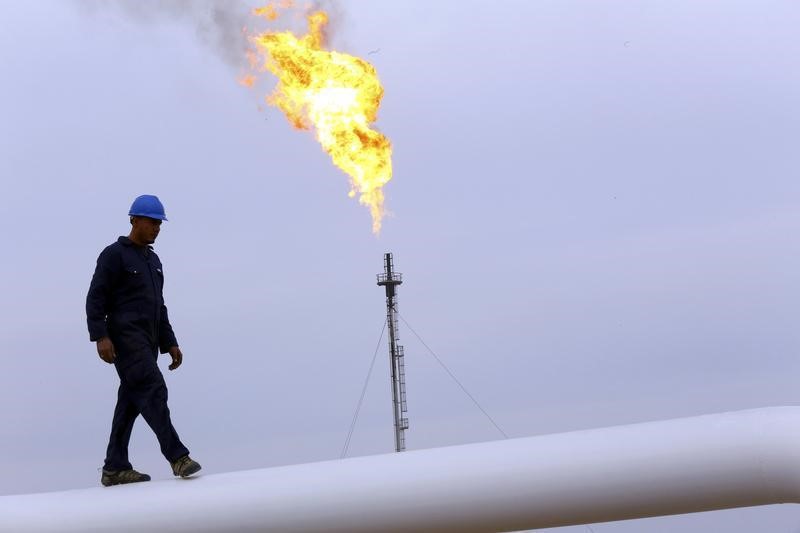By Barani Krishnan
Investing.com - Reality finally seems to be setting in on the oil market.
After initially defying blockbuster crude builds reported back-to-back by the U.S. government in pursuit of what they believed would be oncoming Chinese demand, those long the market finally yielded to something greater: incessant data on creeping inflation, accompanied by calls for appropriate rate hikes.
"Crude prices are falling as supplies are plentiful and as global growth concerns return," said Ed Moya, analyst at online trading platform OANDA. "Oil is seeing steady selling pressure and the true test will be if prices can break below the $72-a-barrel level. "
New York-traded West Texas Intermediate, or WTI, crude for March settled down $2.15, or 2.7%, to $76.27. WTI’s session low of $75.08 marked a near two-week bottom. For the week, the U.S. crude benchmark was down 4.4%. WTI has fallen in three of the past four weeks, losing nearly 7% in that stretch.
London-traded Brent crude for March delivery settled down $2.14, or 2.5%, at $83. Brent’s intraday bottom was $81.81, a low since Feb. 6. For the week, the global crude benchmark was down 4%. Like WTI, Brent has slid in three of the past four weeks, losing more than 5% in that period
"We should remember that the economy triumphs over everything and there's a renewed threat to that now from inflation," said John Kilduff, partner at New York energy hedge fund Again Capital. "Oil prices greatly add to headline inflation. We can make an exception for them to be higher if there’s commensurate demand, but not when there's tons of supply."
"So, the bottom is finally falling out of the oil market as it should have after that mega build," Kilduff said, referring to the 16.3-million-barrel crude inventory increase reported on Wednesday by the U.S. Energy Information Administration, or EIA, for the week ended Feb. 10.
The build was the fourth largest cited by the EIA in its history of reporting on oil supply/demand in the United States. It came after the previous week's increase of 2.4 million barrels and marked the eighth straight week of higher inventories that have added nearly 51 million barrels to supply.
Traders of most risk assets — except possibly those in oil — have been spooked all week by one data point after indicating stubbornly higher inflation despite a year of rate hikes by the Federal Reserve.
US wholesale prices, one of the key determinants of inflation, rose their most in seven months in January, the Labor Department reported on Thursday.
That was after Tuesday's report on consumer prices from the department that again suggested stickier-than-thought inflation.
Since the updated data on inflation emerged, Federal Reserve officials have been girding for an extended period of high interest rates, including a return to a 50-basis point hike in March, saying creeping inflation makes the 25-basis point quantum that the central bank agreed on this month untenable.
“We need to continue rate hikes until we see more progress,” Fed Governor Michelle Bowman said Friday. “Inflation is still far too high. Your guess is as good as mine as to what happens next in the economy.”
Richmond Fed President Tom Barkin concurred, saying controlling inflation would require more rate increases. “How many, we'll have to see," he added.
The comments by Bowman and Barkin came on the heels of more rate warnings earlier in the week from other officials at the central bank.
Cleveland Fed chief Loretta Mester said Thursday US interest rates need to rise to above 5% and remain there an extended time in order to bring inflation down meaningfully.
St. Louis Fed President James Bullard, often viewed as the most hawkish official at the central bank, also said on Thursday he hadn’t been in favor of lowering the quantum of rate hikes — something that happened the last two months — until inflation was under better control.
Bullard added that he would support a 50-basis point hike at the Fed’s next rate decision on March 22, after the 25-basis point increase on February 1.
Former Treasury Secretary Summers, in rounding up the Fed rhetoric, said there’s a risk of the “Fed hitting the brakes very, very hard”.
“A broadening in US price pressures shows that the Federal Reserve’s monetary tightening to date is having a limited impact, raising the danger of policymakers having to do more than previously envisioned,” Summers added.
The Fed added 450 basis points to rates since March via eight hikes, in its bid to control runaway inflation. Rates currently stand at a peak of 4.75%.
Inflation, as measured by the Consumer Price Index, grew by an annualized rate of 6.4% in January. The Fed’s target for inflation, meanwhile, stands at 2% per year.
Rate expectations for the Fed’s March 22 policy meeting, monitored by foreign exchange traders, remained at 25 basis points on Friday, though that could change with the increasing calls for tighter policing from the central bank’s hawks.
Crude prices treaded water in the past two sessions as bulls in the space tried to bravely ignore the inventory builds reported by the EIA in exchange for projected demand from China, the world’s largest oil importer which had just come off stringent COVID-19 measures that had been holding back its energy usage.
Chinese buying has always been a trigger for oil rallies, and expectations for that had been heightened this week by the International Energy Agency, which forecast an additional 500,000 barrels daily from the country this year that would take 2023 global oil demand to a record high.
Analysts, however, said Chinese import data supporting a major oil rally will likely not emerge for at least another two weeks. Meanwhile, latest available data showed the world’s largest crude importer bought 10.98 million bpd, or barrels per day, in January, down from December's 11.37M bpd and November's 11.42M bpd.
